| Author | (Coulter & Rose) Feist & S.R. Downie | |
| Distribution | Known in the state only from a single Carolina bay in Scotland County, in the upper Coastal Plain.
This is very rare species with a disjunct range; occurs from eastern MD to (formerly) DE; and from southern NC to southwestern GA. Thus, it is known only from five states. | |
| Abundance | Formerly was quite common at the site, with 10,000 or more stems in 1986. However, it was last seen in 2004, and repeated searches have failed to find it, including 2022 when conditions were favorable. Until a few years ago, the NCNHP had the State Rank at S1?; however, in 2024 the NCNHP did move the State Rank to SH (Historical). This is a Federal and State Endangered species, with a Global Rank of G2. | |
| Habitat | In NC known only from a clay-based Carolina bay with a scattered cypress canopy -- a Cypress Savanna habitat. Lowered water levels have allowed Loblolly Pines and other woody species to invade the bay, create a dense canopy, and draw down the water levels or water table below the bay. Much pine removal has taken place, but since then water levels have been too high to allow field searches. | |
| Phenology | Blooms from July to September, and fruits from August to October. | |
| Identification | This species is very similar to the much more numerous, though still scarce in NC, T. filiformis. Each is a tall herb growing to 3 feet tall or more, but with a slender stem. There are a few stem "leaves", each being "septate phyllodes" -- essentially just petioles, to about 6 inches long. The one to several umbels have very small white flowers. In this species, the lower "leaves" often drop by the time of flowering, whereas they are generally retained during flowering in T. filiformis. Also, this species has only 5-9 rays/umbellets per umbel, as opposed to a much more impressive 10-30 rays/umbellets per umbel in T. filiformis. There are also differences in the fruits of these two; see Weakley (2018) for details. T. filiformis is not yet known from the Carolina bay where T. canbyi grows, nor from Scotland County, nor apparently from Carolina bays. Even so, take care in identifying these two species. | |
| Taxonomic Comments | These two species were previously, and often currently, placed in the genus Oxypolis.
| |
| Other Common Name(s) | Canby's Dropwort | |
| State Rank | SH | |
| Global Rank | G2 | |
| State Status | E | |
| US Status | LE | |
| USACE-agcp | OBL link |
| USACE-emp | OBL link |

